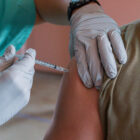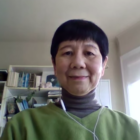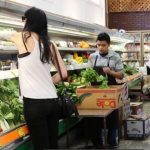In addition to mass vaccination sites and pharmacy megachains, coronavirus vaccine is being distributed by community clinics that serve populations where they’ve built strong connections and trust — through language and cultural competency or by serving low-income families. North East Medical Services has 10 clinics in San Francisco and around the Bay Area, serving some 70,000 patients, many of whom are low-income Chinese speakers. Kenneth Tai, chief health officer, and Jessica Ho, government affairs and community liaison for North East Medical Services, talked with “Civic” about their vaccine distribution strategy.
About 90% of the clinics’ 700 staff members have been vaccinated, Tai estimated, and North East Medical Services has also given doses to health care workers at other clinics. Now, the organization is vaccinating its patients who are 65 and older. While patient inquiries about getting vaccinated have flooded the clinics’ phone lines, Ho said attitudes about the vaccine from seniors they serve have run the gamut.
“We have patients that are calling non stop wanting the vaccine today. And that’s great, right? We want people, especially our seniors, 65 years and older, to come. But then we’ve also seen the flip side where we do have some vaccine hesitancy among some of our patients,” Ho said.
The clinics are developing systems for communicating with patients about vaccination scheduling that do not rely on a patient’s ability to browse the web or use smartphone apps to fill out questionnaires or make appointments.
“We mainly serve a low-income, Asian, monolingual Chinese-speaking population. So there is definitely a digital divide as well, not just the language and health literacy,” Tai said. “We’re finding out a lot of our patients may have a cell phone and maybe text functionality. But a lot of them actually don’t have email addresses, which really complicates the registration process quite significantly.”
North East Medical Services recently began communicating with patients about vaccines via text message, but Tai said staff members may need to also offer explanations about the vaccines and questionnaires in person.
Ensuring vaccine supply has been one of the biggest logistical challenges, Ho and Tai said. North East Medical Services has a standing meeting with the San Francisco Department of Public Health, she said. Her organization and other clinics fill out a survey every week to communicate their vaccine needs. When the health department receives its shipment of vaccines, it must determine allocation to vaccination centers based on how big the shipment is and how much need the sites report. Sometimes clinics must advocate for more doses if an allotment isn’t enough for the appointments they have scheduled, and the department queries its vaccination sites to see if any doses can be redistributed.
As part of the San Francisco Community Clinic Consortium, which serves more than 100,000 low-income San Francisco patients, North East Medical Services made a case for the city to allocate more doses to community clinics. The mass vaccination sites that seemed to receive the lion’s share of doses, Tai said, often can’t help patients who speak a language other than English or Spanish.
“We really have to, as a group, really advocate to the city to demonstrate our vulnerable population with language cultural barriers, why we can serve them a lot better,” Tai said. “We’ve been around for 50 years. And we’re embedded within the community, we know our patients so well.”
A segment from our radio show and podcast, “Civic.” Listen at 8 a.m. and 6 p.m. Tuesdays and Thursdays at 102.5 FM in San Francisco, or online at ksfp.fm, and subscribe on Apple, Google, Spotify or Stitcher.










